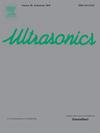On the use of a Transformer Neural Network to deconvolve ultrasonic signals
IF 3.8
2区 物理与天体物理
Q1 ACOUSTICS
引用次数: 0
Abstract
Pulse-echo ultrasonic techniques play a crucial role in assessing wall thickness deterioration in safety-critical industries. Current approaches face limitations with low signal-to-noise ratios, weak echoes, or vague echo patterns typical of heavily corroded profiles. This study proposes a novel combination of Convolution Neural Networks (CNN) and Transformer Neural Networks (TNN) to improve thickness gauging accuracy for complex geometries and echo patterns. Recognizing the strength of TNN in language processing and speech recognition, the proposed network comprises three modules: 1. pre-processing CNN, 2. a Transformer model and 3. a post-processing CNN. Two datasets, one being simulation-generated, and the other, experimentally gathered from a corroded carbon steel staircase specimen, support the training and testing processes. Results indicate that the proposed model outperforms other AI architectures and traditional methods, providing a 5.45% improvement over CNN architectures from NDE literature, a 1.81% improvement over ResNet-50, and a 17.5% improvement compared to conventional thresholding techniques in accurately detecting depths with a precision under 0.5.

利用变压器神经网络对超声信号进行反卷积
脉冲回波超声技术在安全关键行业的壁厚恶化评估中起着至关重要的作用。目前的方法面临着低信噪比、弱回波或回波模式模糊的限制,这些都是严重腐蚀剖面的典型特征。本研究提出了卷积神经网络(CNN)和变压器神经网络(TNN)的新组合,以提高复杂几何形状和回波模式的厚度测量精度。考虑到TNN在语言处理和语音识别方面的优势,本文提出的网络包括三个模块:2.预处理CNN;一个Transformer模型;经过后期处理的CNN。两个数据集,一个是模拟生成的,另一个是从腐蚀的碳钢楼梯标本中实验收集的,支持培训和测试过程。结果表明,该模型优于其他AI架构和传统方法,与NDE文献中的CNN架构相比,提高了5.45%,比ResNet-50提高了1.81%,与传统阈值技术相比,在0.5λ以下的精度下准确检测深度方面提高了17.5%。
本文章由计算机程序翻译,如有差异,请以英文原文为准。
求助全文
约1分钟内获得全文
求助全文
来源期刊

Ultrasonics
医学-核医学
CiteScore
7.60
自引率
19.00%
发文量
186
审稿时长
3.9 months
期刊介绍:
Ultrasonics is the only internationally established journal which covers the entire field of ultrasound research and technology and all its many applications. Ultrasonics contains a variety of sections to keep readers fully informed and up-to-date on the whole spectrum of research and development throughout the world. Ultrasonics publishes papers of exceptional quality and of relevance to both academia and industry. Manuscripts in which ultrasonics is a central issue and not simply an incidental tool or minor issue, are welcomed.
As well as top quality original research papers and review articles by world renowned experts, Ultrasonics also regularly features short communications, a calendar of forthcoming events and special issues dedicated to topical subjects.
 求助内容:
求助内容: 应助结果提醒方式:
应助结果提醒方式:


